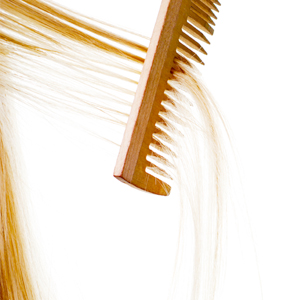My grandfather was the first to point out my baldness. Unlike most women, who begin to notice their hair loss in the form of a concerning number of hairs on their pillow when they wake up or a shower drain clogged with hair that's falling out faster than it's being replaced, I didn't realize I was going bald until a handstand game gave it away. At the back of my head underneath most of my hair was a bald spot. My grandfather recognized it as the beginning signs of alopecia, an autoimmune disease that causes anywhere from a few patches of hair loss on the head to an entire loss of hair (everything -- including eyelashes and eyebrows) all over the body.
My grandfather was diagnosed with alopecia universalis at the age of 40, and I can't remember him ever having a single strand of hair anywhere on his body. I inherited the alopecia gene from him. I got that first bald spot at the age of 9, and was diagnosed with alopecia areata -- unlike my grandfather, my baldness was limited to patches on my head. And, after rubbing some prescribed steroid cream on it, it went away. I stayed bald-spot free for the next 17 years, but at 26 I noticed another bald spot creeping in.
Photo courtesy Laura Zinger
My grandfather was diagnosed with alopecia universalis at the age of 40, and I can't remember him ever having a single strand of hair anywhere on his body. I inherited the alopecia gene from him. I got that first bald spot at the age of 9, and was diagnosed with alopecia areata -- unlike my grandfather, my baldness was limited to patches on my head. And, after rubbing some prescribed steroid cream on it, it went away. I stayed bald-spot free for the next 17 years, but at 26 I noticed another bald spot creeping in.
Photo courtesy Laura Zinger
I wasn't concerned when the same bald patch started showing up. I figured I could just rub some steroid cream on it like I did when I was younger, and it would go away. But this time, instead of disappearing, it got bigger. And then I got a second one, and then they started appearing all over my head. It got to the point where I couldn't cover them up any more. In just six months, I went from having a full head of healthy hair to being completely bald.
When you suddenly start going bald in your mid-20s, it's terrifying. Not only did I have no control over losing my hair, I thought I was seriously ill. The doctor told me I wasn't sick -- my alopecia had just changed from areata to totalis, meaning my bald spots now covered my entire head. As far as I know, it's pretty rare for a person to change from one type of alopecia to another. Since my grandfather lived more than half of his life without hair, I thought that I would be bald for the rest of my life.
Photo by Michelle Kaffko, courtesy Laura Zinger
When you suddenly start going bald in your mid-20s, it's terrifying. Not only did I have no control over losing my hair, I thought I was seriously ill. The doctor told me I wasn't sick -- my alopecia had just changed from areata to totalis, meaning my bald spots now covered my entire head. As far as I know, it's pretty rare for a person to change from one type of alopecia to another. Since my grandfather lived more than half of his life without hair, I thought that I would be bald for the rest of my life.
Photo by Michelle Kaffko, courtesy Laura Zinger
When the doctor told me my only option was getting painful steroid shots into my head regularly, I decided to embrace the bald look. Losing my hair was sad, yes, but I wasn't completely devastated. I wasn't dying (alopecia is not life-threatening); I was just bald. But by the way people reacted to me, you would have thought I was dying. People would look at me like they were afraid. When people start acting afraid of you, it kind of freaks you out. I started asking myself, "Oh my God, is there something wrong with me?"
So after I lost most of my hair, I started wearing wigs. I decided that if I was going to wear a wig, I would have fun with it.
Photo by Michelle Kaffko, courtesy Laura Zinger
So after I lost most of my hair, I started wearing wigs. I decided that if I was going to wear a wig, I would have fun with it.
Photo by Michelle Kaffko, courtesy Laura Zinger
At first, I bought a human hair wig, which turned out to be an awful decision for me. It was $1,200, and incredibly hot and heavy -- especially in Chicago's 90-degree weather and humidity. I was DYING. Plus, you have to wash it every day, and it reacts to humidity -- all the bad parts about having real hair and none of the good! I switched to plastic wigs, which are $40 to $60, and much more comfortable. Because they were cheap, I got a bunch of them. At any given point, I'd have about 20 wigs in rotation. I'd be a blonde one day, and have pink hair the next.
Photo by Michelle Kaffko, courtesy Laura Zinger
Photo by Michelle Kaffko, courtesy Laura Zinger
What's really interesting about wearing wigs is how people treat you differently depending on your hair color. When I wore blonde wigs, I got hit on a lot, especially if the wig was long. It got to the point where I would purposely not wear a blonde wig if I was going someplace where there would be a lot of men, because it just got obnoxious. I lent the long blonde wig to my cousin one day, and someone leaned out of a window and shouted, "whore!" at her.
One time I wore a really short white wig, and the reactions I got were insane. I think a lot of strippers must wear this wig or something, because men were leaning out of cars and shouting at me, which is not an everyday occurrence for me. Finally, I realized -- it's the wig!
Women, on the other hand, treated me more coldly as a blonde. It was interesting to see the reactions to hair color and length, but also it made me sad. Women are treated very differently based on what they look like.
Photo by Michelle Kaffko, courtesy Laura Zinger
One time I wore a really short white wig, and the reactions I got were insane. I think a lot of strippers must wear this wig or something, because men were leaning out of cars and shouting at me, which is not an everyday occurrence for me. Finally, I realized -- it's the wig!
Women, on the other hand, treated me more coldly as a blonde. It was interesting to see the reactions to hair color and length, but also it made me sad. Women are treated very differently based on what they look like.
Photo by Michelle Kaffko, courtesy Laura Zinger




